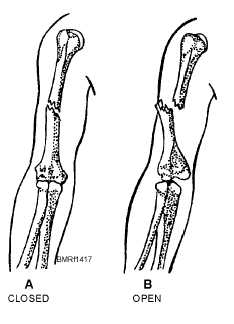Recognize the classification of, symptoms of,
and first-aid treatment for fractures.
Recall the first-aid treatment for strains and
sprains.
Simply put, a fracture is a broken bone. The severity
of the injury depends on the part of the body affected,
the type of fracture, and the amount of tissue damaged.
FRACTURES
In this section, you will learn about fractures—how
they’re classified and the first-aid you would give the
victim. Additional information is given on how to
transport victims.
Classification
Fractures may be classified in several ways.
However, they are generally classified as are either
closed or open. A closed fracture is one in which the
skin remains intact. An open fracture is one in which the
bone protrudes from the skin. These fractures are shown
in figure 14-17.
Symptoms
You can’t always tell that a fracture has occurred.
However, if the victim has been involved in some form
of violence, you may suspect that one or more bones
have been broken. The victim may even have heard the
bone snap. Some symptoms of a fracture are as follows:
Pain and tenderness
Inability to use the part
Creaking or cracking
Motion at points other than joints
Swelling
Deformity
Discoloration of skin
Treatment
If you are required to give first aid to a person who
has suffered a fracture, you should follow these general
rules:
If there is any possibility that a fracture has been
sustained, treat the injury as a fracture.
Get medical aid at the first possible opportunity.
All fractures require medical treatment.
Don’t move the victim until splints have been
applied to the injured parts, unless the victim’s
life is in danger.
Treat for shock.
Don’t attempt to locate a fracture by grating the
ends of the bone together.
Don’t attempt to set a broken bone.
When a long bone in the arm or leg is fractured,
the limb should be carefully straightened so that
splints can be applied. Pulling gently with your
hands in the long axis of the limb is permissible,
and it may be all that is necessary to get the limb
back into position.
Apply splints. Emergency splinting may be
placed over clothing if the victim will be seen
very soon by a medical officer or if the victim
will be transported for a short distance.
Otherwise, it’s best to remove just enough
clothing so you can apply well-padded splints
14-21
Student Notes:
Figure 14-17.—Types of fractures.



